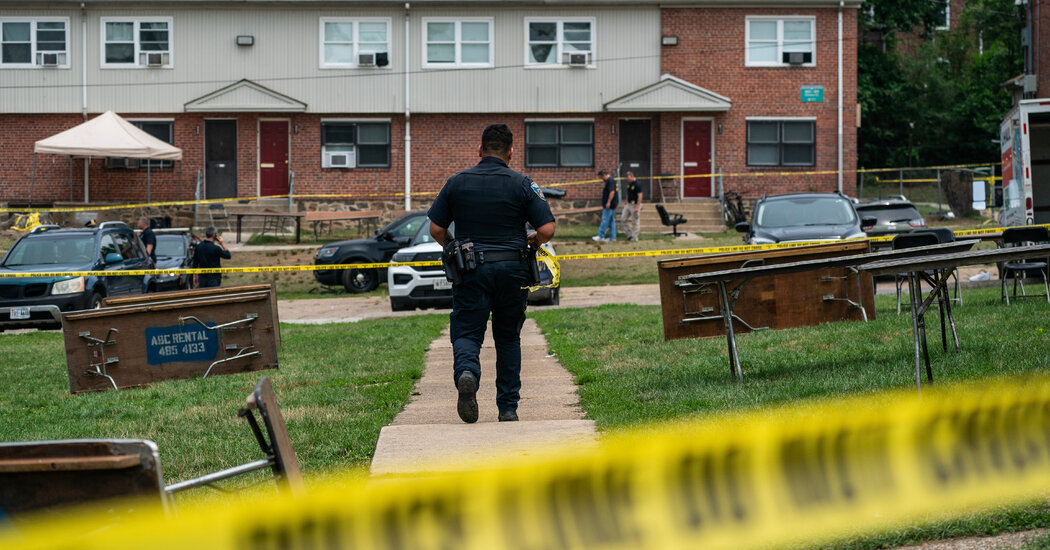Children Risk Their Lives Building America’s Roofs
This is Antoni Padilla, 15. He found work as a roofer in South Carolina after leaving Honduras.
Federal law bars anyone under 18 from roofing because it’s so dangerous. But across the U.S., migrant children do this work anyway.
They call themselves “ruferitos” on social media. In videos like these, they talk about being underage and pose on rooftops and ladders, often without the required safety gear.
The New York Times spoke with more than 100 child roofers in nearly two dozen states, including some who began at elementary-school age. They wake before dawn to be driven to distant job sites, sometimes crossing state lines. They carry heavy bundles of shingles that leave their arms shaking. They work through heat waves on black-tar rooftops that scorch their hands.
The rise of child roofers comes as young people are crossing the southern border alone in record numbers. Nearly 400,000 children have come to the United States since 2021 without their parents, and a majority have ended up working, The New York Times has reported in a series of articles this year.
The most common job for these children is under-the-table work in roofing and construction, according to teachers, social workers, labor organizers and federal investigators. Roofing is plentiful and pays better than many of the other jobs these children can get.
In New Orleans, Juan Nasario said he had been replacing roofs during 12-hour shifts nearly every day since he arrived from Guatemala four years ago, when he was 10. He would like to go to school or at least join a soccer team, but he needs to pay rent to his older cousin.
In Dallas, Diego Osbaldo Hernández started roofing at 15, after coming to the United States from Mexico last year to live with an older friend.
Diego Osbaldo Hernández, now 17, often documents his days working on roofs across Texas.
Courtesy: Diego Osbaldo Hernández
His jobs take him all across Texas, but his favorite place to work is San Antonio. “They are the shortest houses,” he said.
The federal government pledged to crack down on child labor earlier this year. But this roofing work force continues to grow as fast as children arrive, anxious to find a way to support themselves and help their families out of poverty.
A Plunge From the Third Story
In Honduras, Antoni lived with his four siblings in a one-room home without electricity. He had worked since he was small, carrying food out to field hands.
He arrived in the U.S. in 2021 and joined a roofing crew. He shot videos like this one to show his family the steep drops below.
Roofing left Antoni little free time, but his earnings covered room and board at an uncle’s house near Myrtle Beach, and he started sending money home.
In the spring of last year, he was working on this beach house.
He was inching backward collecting shingles when he slipped and fell nearly 30 feet. He slammed into this cement patio.
At the hospital, Antoni lay in a coma with severe brain trauma, breathing through a tube in his neck. His skull was fractured, a lung was punctured and he was bleeding internally throughout his body. His family in Honduras said their goodbyes on speakerphone.
“Very poor outcome anticipated,” his surgeon wrote.
But after three months, he woke up, and the doctors said he could leave. No rehabilitation facility would accept him without health insurance. Unable to speak or stand, he went back to the trailer he had been sharing with his uncle’s family. He stayed inside for the next several months.
Children working on construction sites are six times as likely to be killed as minors doing other work, according to the National Institute for Occupational Safety and Health. Roofing is particularly risky; it is the most dangerous job for minors other than agricultural work, studies show.
Labor organizers and social workers say they are seeing more migrant children suffer serious injuries on roofing crews in recent years.
A 16-year-old fell off a roof in Arkansas and shattered his back. A 15-year-old in Florida was burned all over after he slipped from a roof and onto a vat of hot tar. A child in Illinois stepped through a skylight and fractured his spine.
Even falls that do not result in major injuries instill a sense of dread in some young workers. Cristian Marcos has been working on multimillion-dollar homes in the Miami area since he arrived from Guatemala in 2021, when he was 12. He once fell from a second story while installing a roof and walked away with only bruises.
“When you fall, you might be fine, or you might be dead,” he said in a whisper during a lunch break.
Terry Coonan, who runs a human rights center at Florida State University, often comes across children after they have been discarded by their employers. One 15-year-old boy from Central America who had been traveling around the country with a crew boss was abandoned last year after being injured on a work site. The boy was found alone and crying in a ditch.
“He was of no more use,” Mr. Coonan said.
‘This Incident May Have Been Prevented’
Juan Ortiz, 15, was installing metal roofing at a plant in Alabama in 2019 when this patch of insulation gave way and he fell onto a concrete floor.
After his death, the federal Occupational Safety and Health Administration found that the employer had “nine laborers on the crew, but only six harnesses.”
Andrés Toma, 16, was not clipped into a harness when he fell to his death while replacing this roof in Florida in April. “This incident may have been prevented,” OSHA wrote.
He had been earning $70 a day. His older sister said the family had not known he was roofing, “just that he had found a good job that paid well.”
Crisanto Campos, 17, was electrocuted while raising a pallet of shingles onto this rooftop in Louisiana last year. It was his first time operating a forklift.
The OSHA report said another worker had survived a similar “near miss” the previous day.
About 100 roofers are killed on the job each year, most often in falls, according to the Department of Labor. The government does not publish data about injuries or fatalities among child roofers — a category of workers that is not supposed to exist.
Some crew bosses understand the risk to their young workers and keep newly hired children on the ground, picking up discarded shingles and hoisting bags of new ones onto ladders.
But there is a powerful incentive to get on the roof: Laying down shingles pays more than double what helpers earn.
When they do get onto roofs, children said, they often work without harnesses or safety training. Some rely on dangling ropes to keep their balance. Others described struggling to keep their footing while shuttling bags of shingles.
“One is OK,” said Miguel Santos, who started this work last year in New Orleans at 16. “But two is very, very heavy.”
When these children get hurt, contractors often refuse to pay medical bills.
Mourners gathered around the coffin of 16-year-old Andrés Toma at his funeral in Guatemala this spring.
Source: Conjunto San Miguel Arcángel Vichibalá, via Facebook
Families of young workers who die face another challenge: finding the money to bring their child’s body home to be mourned and buried.
Cracks in Enforcement
A 16-year-old from Honduras spent September working with this crew in South Carolina.
Itzel Sánchez, the crew boss, says she hires underage workers because she doesn’t like to turn away children who are in need.
They are also much cheaper to employ.
Ms. Sánchez says helmets and harnesses are too cumbersome. If she hears inspectors are coming, the crew runs to the equipment trailer.
Children find roofing work through churches, in Facebook groups and at day labor sites, where workers of all ages gather in the mornings in hopes of being chosen for jobs. They sometimes say they are older than 18, but subcontractors rarely ask them to prove it.
Ms. Sánchez does not worry about getting in trouble for hiring minors. She said workplace inspectors do not often come around.
“They only visit certain neighborhoods, and sometimes they let you know when they’re going to show up,” she said.
Ms. Sánchez and other subcontractors said they have turned to children because there are not enough adults willing to do this work. Roofing industry experts say firms have struggled with a labor shortage amid residential building booms across the South and an uptick in hurricanes and other natural disasters.
The Times found children replacing the roofs of big box stores, government-owned buildings and campus housing, as well as private homes. Some were working for bosses who had themselves arrived not long ago as unaccompanied children.
The Department of Labor, which is in charge of enforcing federal child labor laws, has not kept up with the industry’s shift. The department has brought an average of seven cases a year over the past decade, imposing less than $6,000 in fines per case.
Miguel Santos, 17, waiting at a corner with other day laborers at a gas station in New Orleans.
Nicole Salazar for The New York Times
In a statement, the department noted that it had just 731 investigators overseeing 11 million workplaces. Jessica Looman, administrator of the department’s wage and hour division, said the department was requesting more funding from Congress to protect migrant children.
“Stories like the ones we are seeing in roofing and many other industries are exactly why we have stepped up our child labor enforcement,” Ms. Looman said.
In the small Florida city of Homestead, The Times spoke with 20 migrant child roofers, some as young as 13, at day labor sites.
Not far away, Ileana Bachelier, a career investigator with the Labor Department, was attending a Homestead community event. She said that she responded to all child labor tips, but did not have the time to chase down roofing cases on her own in the absence of a complaint. “I’m not going to make it my duty to go out and look for it,” she said. Ms. Bachelier has since left the department.
Investigators have imposed one child labor fine for roofing in South Florida over the past 15 years, for about $13,000 in 2017, according to a Labor Department database.
Even when OSHA, the Labor Department’s safety enforcement arm, responds to accidents that kill or maim migrant children, The Times found that inspectors sometimes fail to follow policy and alert child labor investigators. Other times, investigators open cases but then let them drop.
After questions from The Times, the department is revisiting several cases, including two fatalities. None of the deaths in this story have resulted in any child labor fines.
After the Accident
About five months after his fall, Antoni testified in a workers’ compensation case. He was asked to raise his right hand and swear to tell the truth.
He could not lift his arm and struggled to understand basic questions.
Antoni could not remember what state he was in, or his father’s name. His brain injuries have severely impaired his memory and speech.
He has trouble dressing himself, and he’s unsteady on his feet.
But it is still important to him to help his relatives. He tries to eat on his own and washes the family’s dishes, balancing plates against his chest to transfer them to dry.
As soon as Antoni regained some of his speech, he began asking when he could go back to Honduras to see his parents.
He was likely eligible for workers’ compensation, but the company that had been hired to do the roofing job had subcontracted it out to a smaller company, which subcontracted it again. The three contractors spent a year arguing over who should be held liable. They are in the process of settling, but it is unclear how Antoni’s family will support him in Honduras. They live hours from the kind of medical care he needs.
State labor investigators cited one of the companies for violating child-labor laws. The fine was $500.
For now, Antoni lives in the same trailer. His uncle was killed in a car crash this spring while driving to get Antoni’s anti-seizure medication, and so he relies on his aunt for needs as basic as walking down the front steps.
His parents share the hope that their son will return from South Carolina, but have struggled to help him understand that he needs to stay put until they can figure out how to care for him.
They check on him twice a day, and Antoni counts down the hours to their calls. He smiles and laughs when talking to them, and speaks with flashes of the lively child he used to be. “I miss you so much,” his father said on a recent call. “But you have to hang on. We’ll see each other again.”
Antoni Padilla, now 17, on a phone call with his father in Honduras.
Brent McDonald/The New York Times
Antoni often spends his days sitting on his bed, scrolling through TikTok videos posted by other child roofers — the vast network of ruferitos who capture the view from spindly ladders and shingled rooftops across the country.
On a recent afternoon, he smiled as he looked at his phone. “That’s how it was,” he said. He took in the songs about coming to America for a better life, the selfies with steep drops in the background, the emojis of flags from Guatemala and Honduras. They reminded him of the thing he most holds onto when the rest of his memories are hard to summon. “I was sending home $300 a month,” he said.
Reporters
Hannah Dreier, Brent McDonald, Annie Correal, Nicole Salazar, Carson Kessler
Produced by
Gray Beltran
Cinematography
Brent McDonald, Gustavo Acosta, Ray Whitehouse
Photography
Brent McDonald, Nicole Salazar
Video Editor
Caroline Kim
Senior Video Producer
Jeesoo K. Park
Editors
Kirsten Danis, Rumsey Taylor, Lanie Shapiro
Research
Kirsten Noyes, Alain Delaqueriere, Kathleen Flynn
Photos and videos of Antoni Padilla courtesy of the Padilla family
Archival materials courtesy of Cullman Police Department, Occupational Safety and Health Administration, Jefferson Parish Sheriff’s Office
Editor’s note: Additional videos of child roofing appear courtesy of the roofers.


